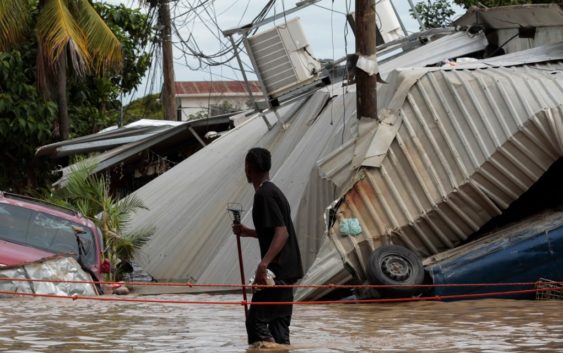- The Texanist: Texas Gets More Tornadoes Than Any Other State, but Don’t Freak Out
- U.S. Supreme Court says Texans can sue state for flood damage
- This is how many hurricanes NC State researchers predict this year
- NC State researchers predict above-average hurricane season
- Supreme Court rules in favor of property owners suing Texas over flood damage
How two powerful hurricanes in a row could impact Central America

In Nicaragua, Honduras and Guatemala, the road to recovery from Hurricane Eta’s impacts has been a swamped mess.
For a flooded region, more torrential rain in the forecast could present another round of deadly dangers. Nothing could be worse right now for the countries of Central America than a second punch from yet another major hurricane.
In Nicaragua, Honduras and Guatemala, the road to recovery from Hurricane Eta’s impacts has been a swamped mess. While organizations like Mercy Corps, a humanitarian aid group, are just beginning to reach affected communities, the impending landfall of Hurricane Iota could complicate aid and recovery efforts exponentially.
“We have seen more than 980,000 affected by Eta and still over 17,000 people are still in shelters,” Lynn Hector, media and communications manager for Mercy Corps, told AccuWeather. “For us, the biggest challenge is access. There are downed trees, flooded roads, washed-out bridges and with the arrival of Iota we expect additional flooding and overflowing rivers and landslides, which could make it even harder than it has been over the past couple weeks to even access the communities, particularly rural communities, that are most affected.”
To make matters worse, Iota isn’t just any hurricane. It’s the strongest storm of the entire 2020 season.
A Category 4 landfalling hurricane packs enough power to leave a deadly imprint on a nation by itself. However, as the storm made landfall near the same area already weakened by Eta, organizers feared the worst.
“It could be devastating, no matter its strength. The soil is completely saturated and the land is still unstable from Tropical Storm Eta,” Miriam Aguilar, a Mercy Corps’ country representative working in Guatemala, said on Monday.
According to Hector, the people of Guatemala are exhausted from the impacts of Eta and concerned for what lies ahead. In Alta Verapaz, where the organizations works, more than 50% of that population lives in extreme poverty and more than 80% lives in poverty.
“What little they have has already been or will soon be washed away. Two major hurricanes in the span of two weeks is just unfathomable for many, it will completely devastating,” Hector said. “For many who have left their homes to seek refuge in shelters, they don’t even know right now what they will come back to.”
With 15 to 20 feet of storm surge in the forecast, entire cities are likely to find themselves underwater yet again, presenting many of the same deadly scenarios that Eta brought earlier this month.
As Eta showed, a hurricane’s deadly ramifications don’t end after the rain and winds move out. Deadly landslides triggered by weakened soil and the lack of sanitary drinking water claimed at least hundreds of lives over the past couple of weeks.
It’s scenarios like that which Mercy Corps has worked to prepare for ahead of Iota’s arrival Monday evening.
“This coming week we plan to install six water storage tanks at evacuation shelters in Alta Verapaz to ensure evacuees have reliable access to clean water,” Aguilar said. “Whether we can do that depends entirely on access in the days ahead as Iota passes over.”
In recent days, search and aid efforts for Eta victims have been forced to be called off due to the unstable conditions of the soaked grounds of Guatemala. On Saturday, President Alejandro Giammattei ordered evacuations in the towns of Alta Verapaz and Quiche, where mudslides claimed dozens of lives and left many others missing, Al Jazeera reported.
Honduras President Juan Orlando Hernandez echoed similar sentiments about the one-two punch.
“We are concerned about the area of Alta Verapaz and Quiche,” Giammattei said. “We believe that they are the areas where we could have the greatest impact. We hope God helps us.”
On top of it all, the COVID-19 pandemic continues to wage war on countries around the world, refusing to have mercy even on hurricane-torn areas.
In a Mercy Corps press release, Aguilar said her organization is focused on reducing transmission risks in whatever ways are possible.
“The risk of COVID-19 spreading will only increase as more seek refuge in shelters, already crowded with more than 17,500 Guatemalans from the last storm,” she said. “There are also many informal shelters and small camps stood up by communities themselves, using improvised structures, lacking basic services and extremely vulnerable to any new adverse weather conditions. They are at even greater risk of disease transmission.”
Aguilar added that it is critical for displaced families to have access to masks and hygiene supplies in order to prevent the spread of the virus.
As the world watches in horror at the tragedies that repeatedly strike Central America, Hector is asking people to provide whatever assistance they are able to donate.
“This is a region that faces a number of challenges: Widespread poverty, malnutrition, increasing effects due to climate change and now COVID-19. The effects of Eta have been so severe for this region and we know that more damage is coming,” she said. “Regardless of its strength, we’ll see more saturation of the soil, we’ll see intense flooding in some areas, so we’re just really concerned and we want the world to be concerned as well, to provide whatever assistance they can to the people of Central America as they weather these storms.”
Keep checking back on AccuWeather.com and stay tuned to the AccuWeather Network on DirecTV, Frontier and Verizon Fios.